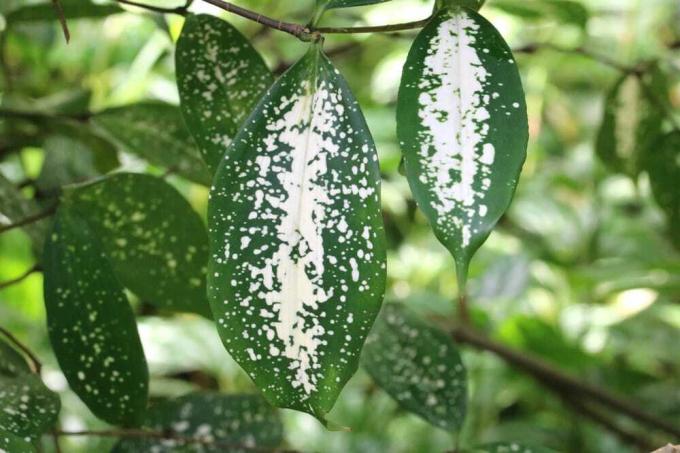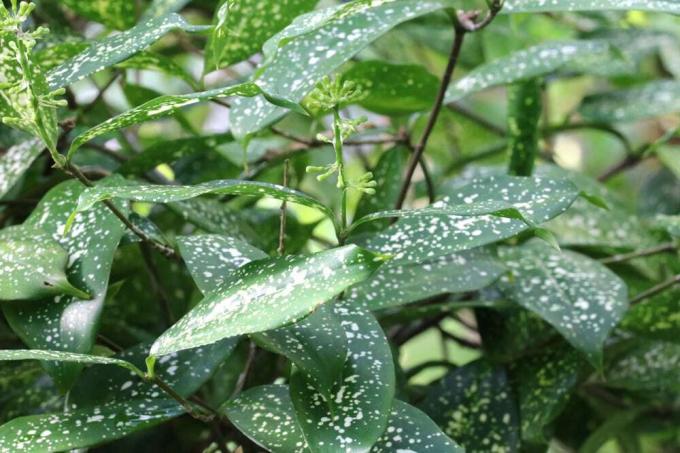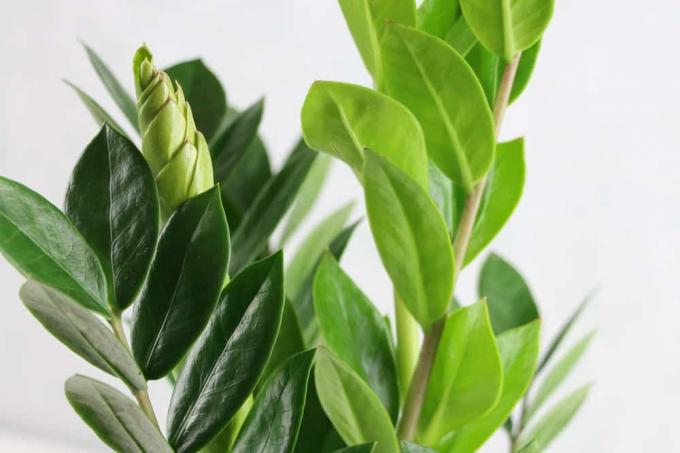

Table of contents
- Characteristics
- Location
- substrate
- care instructions
- Pour
- Fertilize
- Cut
- hibernate
- repot
- Switching from soil to hydroponics
- Instructions
- After repotting
- multiply
- cuttings
- division
- Diseases
- pests
The dragon tree, native to tropical Africa, is offered with more or less intensively patterned leaves. The white flowers are particularly filigree, but only rarely develop in indoor culture. But even without flowers, these leafy beauties convey a touch of the exotic. In addition, they can remove harmful substances such as formaldehyde, xylene and benzene from the air in the room.
Characteristics
- Botanical name: Dracaena surculosa
- German name: dragon tree
- plant family: Asparagus family (Asparagaceae)
- Origin: tropical Africa
- Growth: slow, bamboo-like
- growth height: 60-70cm
- Blossom: filigree, white, strongly scented
- heyday: January to December
- Sheet: oval, dark green, slightly spotted
- Toxicity: slightly toxic
- Use: Indoor houseplant
Location
The dragon tree 'Dracaena surculosa' likes it warm and bright. As a rule, it does well in both light and partially shaded locations. In a bright place, the beautiful leaf markings are particularly pronounced and the darker it is, the greener the leaves are. However, direct sunlight should be avoided as it could burn the leaves.
Drafts and dehydration should also be avoided. Depending on its origin, the plant depends on temperatures that are as constant as possible. Ideally, it should be between 20 and 25 degrees during the day and should not fall below 15 degrees at night. During the summer, the dragon tree can also stand in the garden, on the balcony or terrace in a place that is protected from the blazing sun.
substrate
This plant is not picky about the substrate. So you can easily use commercially available pot or house plant soil, which you loosen up with sand or gravel. For the sake of the environment, peat should be avoided if possible. The pH should be slightly acidic to neutral. be between 5.5 and 7. Special palm soil could also be considered. If you want, you can prepare a suitable substrate mixture yourself. This can consist of one third of commercially available potting soil and loamy garden soil and one sixth of coarse sand and pumice.
Tip:
The most important factor is good permeability. Compacted substrates can lead to the formation of waterlogging, which in turn leads to rot in the root area and the associated loss of leaves.
care instructions
In general, this dragon tree species is very undemanding and requires relatively little maintenance. Of course, this requires the right location and needs-based supply. She usually forgives minor care mistakes and recovers quickly.
Pour
- Water requirement dependent on temperature, light intensity and size of the plant
- Leaves turning brown or yellow, signs of over-wetting
- Allow the substrate surface to dry well before each watering
- The root area should never dry out completely
- Even waterlogging is not tolerated
- For watering, rain or use low-lime water
- Also applies to specimens in hydroponics
- The water level can also show 0.0 for a short time
Tip:
Since this houseplant requires high humidity, regular spraying with soft water is recommended.
Fertilize
earth culture

Freshly bought or repotted plants do not have to be fertilized at first. Otherwise, you fertilize during the growth phase, from about April up to and including September. Complete fertilizers in solid and liquid form as well as long-term fertilizers in the form of fertilizer sticks are suitable. Ideally, liquid fertilizer is preferred, as solid fertilizers are not so easy to dose. It is administered every two weeks with the irrigation water according to the specifications of the respective manufacturer. From late summer into autumn, the fertilizer application must be reduced and then stopped completely.
hydroponics
In hydroponics, small clay balls serve as a substrate. The disadvantage is that they contain no nutrients or can store them. Accordingly, they must be fed from April to September in the form of liquid fertilizers. It is particularly important to ensure that the respective fertilizer is not used pure or to be administered undiluted. Otherwise, it could burn the delicate roots. The right fertilization can be decisive, especially for the formation of flowers, even if Dracaena surculosa only rarely develops flowers in indoor culture.
Cut
- Pruning is not mandatory but possible
- When the plant is weak or better branching is desired
- Or has formed long, weak shoots in an unfavorable location
- In addition to cutting, look for a more suitable location
- Cutback possible at any time
- Best time in spring
- Prune just before the period of most intense growth
- If the time is unfavorable, wait longer for budding
- Cut at almost any point possible
- But always at the level of a leaf base
- Pruning measures bring more light into the interior of the plant
- Make the plant regrow more compact
hibernate
As a houseplant, Dracaena surculosa needs a rather warm spot all year round. The optimal hibernation temperature is between 15 and 18 degrees. A brief drop below 15 degrees is tolerated. However, it should not be exposed to such temperatures for longer periods of time, otherwise it would quickly droop. Even in winter he likes to be bright but not sunny. Watering is reduced during the cold season without the bale drying out completely.
Fertilizers should be completely avoided. During the heating period, the air in the room is usually very dry. However, since the dragon tree needs high humidity at any time of the year, it should be sprayed regularly with water, especially in winter. It is also advisable to remove dust from the leaves at certain intervals with a damp cloth.
repot
A newly purchased dragon tree plant should be repotted as soon as possible after purchase. For all other specimens, it is advisable to repot them about every two years. Normal potting soil, even those containing peat, tends to sag over time, causing it to compact. This affects the permeability of the substrate and thus the availability of oxygen. This can take a toll on this plant. The new pot should be about 20% larger and have a drainage layer. The plant is removed from the old pot and the loose soil removed from the root ball. Then it is placed in the new pot in fresh substrate and watered.
Switching from soil to hydroponics
Dracaena surculosa can also be grown very well in hydroponics, which has some advantages. On the one hand, it makes maintenance easier and, if handled correctly, there is no risk of waterlogging or fungal diseases. There is no soil that needs to be replaced regularly, soil-dwelling pests and mold don't stand a chance. The substrate, which consists of small clay beads, is stable for years.

It only needs to be repotted if the pot is too small or too large. the root ball has grown too large. Even allergy sufferers can breathe easy. It is of course best to cultivate the plants in hydro pots from the start. Switching from soil to hydro later on is more difficult and a lot more stressful for the plants, but still possible. The best time to do this is in spring. The plant to be transplanted should always be young.
Instructions
- Remove the plant from the pot and remove soil from the root ball
- Wash out the last remains of soil with a weak jet of water
- Damage roots as little as possible
- Remove rot and yellow leaves
- Then fill the hydro vessel about a quarter full with clay pebbles
- Then insert the plant in the middle
- Fill up with granules
- Roots should be covered with a layer of granules
- Bump open the pot several times in between to close gaps in the substrate
After repotting
Now the roots of the plant in question must reach a certain length in order to be able to penetrate the water in the reservoir. To do this, keep the expanded clay balls constantly moist and place the dragon tree in a semi-shady place with high humidity for two to three weeks. As soon as regular growth has started, water can be filled up to the optimum mark according to the water level indicator. Now is also the right time to administer a suitable long-term fertilizer. The water level is checked once or twice a week, no further maintenance is necessary.
Tip:
In hydroponics, this houseplant can easily be left to itself for three weeks in a location that is not too hot. However, this presupposes that the water tank was previously filled to the maximum of the water level indicator.
multiply
The dragon tree (Dracaena surculosa) can be propagated by cuttings or division. We show you how to do it correctly and what you should pay attention to:
cuttings
The most common method of propagation is via cuttings. This can be obtained, for example, by pruning regularly or by cutting it off the mother plant in spring or summer.
- Cut the cuttings about 15 cm below the shoot tip
- Seal the interface on the mother plant with tree wax
- Cut leaves in half to minimize evaporation
- Then fill small pots with permeable growth substrate
- Or use an equal parts mixture of soil and sand
- Insert freshly cut cuttings into the prepared substrate
- Press the soil down lightly
- Moisten the substrate and keep it constantly moist until rooting
- Cover cuttings with translucent foil
- Place in a bright, not sunny and evenly warm place
- Soil temperature should be 24-25 degrees
As an alternative to soil cultivation, the cuttings can also be rooted in a glass of water. They are placed in a dark vessel filled with water. Once roots have formed, they can be planted. Rooting in both soil and water takes about two to three weeks.
division
Thanks to its stalk-like stems, this plant belongs to the species that can also be propagated by division. To do this, take them out of the pot in early spring and carefully shake off the loose soil. With your hands you expose the roots as much as possible and remove damaged and rotten root parts. Then they are separated into several parts. Each of them must have enough roots to grow. Finally, the newly acquired plants are used and watered well.
Diseases

Plant diseases are very often the result of insufficient care or unfavorable site conditions. These can be strong temperature fluctuations as well as excessive watering or exposure to sunlight. Errors in fertilization or frequent watering with tap water are often the cause. In order to prevent all this, you should ensure optimal environmental conditions and care that is appropriate to the species and needs.
pests
scale insects
Under unfavorable conditions, the plants are also more susceptible to pests such. B. scale insects. You can recognize them by small brown labels on the leaves and stems. To combat it, you can dab the pests directly with tea tree oil or brush them with a soft soap solution and repeat the whole thing several times. The use of parasitic wasps is also an option. Chemicals should only be used when the infestation is very advanced.
Mealybugs or mealybugs
Small cotton-like webs are typical of an infestation with mealybugs. The leaves turn yellow, curl up and eventually fall off. Affected plants should be isolated from others as soon as possible. Then we recommend combating it with a mixture of one liter of water, 15 ml each of spirit and paraffin oil or curd soap. The mixture is applied with a brush and the procedure is repeated several times, at intervals of two to three days.
 garden editorial
garden editorial I write about everything that interests me in my garden.
Learn more about indoor plant dictionary

Ornamental asparagus, Asparagus densiflorus: Care from A - Z
Ornamental asparagus is a popular decoration for the garden or balcony. The following guide with tips for care from A to Z shows how Asparagus densiflorus and other species of the plant such as Asparagus plumosus or Asparagus sprengeri can be cultivated.

Easy-care office plants - 18 plants for the office
If you have the opportunity to make your office a little more personal, you often use office plants because they have several good properties. You can find out which indoor plants are suitable here.

20 plants for children's rooms: non-toxic and easy to care for
Decorative plants are part of the design of the children's room. Plants in their own room give the offspring a comprehensive insight into the care of the plants, even if they are easy to care for. It is important when choosing plants that you choose non-toxic species.

Pruning & branching Money Tree, Crassula ovata
The money tree proves to be well tolerated by pruning. With targeted cuts, it can be raised to become a standard tree or formed into a bonsai. There are no limits for your creativity. The plant tolerates rejuvenation cuts as well as educational cuts or the radical removal of all shoots.

10 useful indoor plants for a healthy indoor climate
Indoor plants transform a room into an oasis of well-being. They are decorative and healthy at the same time. They help to improve the room climate by reducing the concentration of carbon dioxide, optimizing the air humidity and binding pollutants from furniture and carpets. Which houseplants are recommended?

Is the lucky feather / Zamioculcas poisonous? Advice for children and cats
The lucky feather is popular because it just keeps growing without much attention. This houseplant, which comes from Africa, develops so beautifully that everyone would like to have it. But one thing to note: it is mildly toxic.



